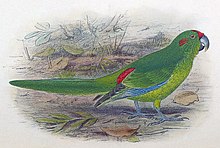Lord Howe Parakeet
| Lord Howe Parakeet | ||||||||||||
|---|---|---|---|---|---|---|---|---|---|---|---|---|

Pair of Lord Howe Parakeets, male bird in foreground (illustration by JG Keulemans ) |
||||||||||||
| Systematics | ||||||||||||
|
||||||||||||
| Scientific name | ||||||||||||
| Cyanoramphus subflavescens | ||||||||||||
| Salvadori , 1891 |
The Lord Howe parakeet ( Cyanoramphus subflavescens ), also known as the Lord Howe parakeet , is an extinct species of parrot that was endemic to Lord Howe Island . For a long time it was considered a subspecies of the goat's parakeet ( Cyanoramphus novaezelandiae ), but was recognized as a separate species in 2008.
features

The Lord Howe parakeet reached a size of 27 cm. The plumage was bright medium green with yellow washes, which stood out especially on the cheeks and on the underside. The forehead region, the reins and the eye line were marked in different reds. The ear covers were indistinctly red. With great individual variability, the red markings on the head of the males were usually somewhat more pronounced. There were red spots on the rump sides. The outer edges of the wings were purple-blue. The upper tail was green with brown washes. The underside of the tail was gold-olive. The beak was blue-gray. The iris was dark red. Legs and feet were dark gray. The Lord Howe Parakeet looked very similar to the Parakeet, but was larger. It differed from the Norfolk Parakeet ( Cyanoramphus cookii ) by the more yellowish plumage and the less red color of the forehead.
die out
Tommaso Salvadori described the species in 1891 on the basis of a specimen that was brought back in 1853 by an expedition of the HMS Herald - one of the ships that were sent to rescue the unlucky ships HMS Erebus and HMS Terror . According to Keith Alfred Hindwood (1904–1971), the extinction was due to overhunting by farmers who viewed the Lord Howe Parakeet as a pest in their gardens and fields. The last evidence comes from the year 1869, when the Australian naturalist Edward Smith Hill (1819-1880) was able to observe a single pair.
Two specimens of this bird species are in the Natural History Museum at Tring .
literature
- Michael P. Walters & Julian Pender Hume: Extinct Birds , Poyser Monographes A & C Black, 2012. ISBN 978-140-815-725-1 , p. 171
Individual evidence
- ↑ McAllen, IAW, & Bruce, MB 1988. The birds of New South Wales . Turramurra, Australia: Australian Biocon Research Group
- ↑ Christidis, L. and Boles, WE (2008). Systematics and Taxonomy of Australian Birds . CSIRO Publishing Melbourne
- ↑ IOC World Bird Names
- ↑ Hindwood, KA (1940). The Birds of Lord Howe Island . Emu 40: 1-86.